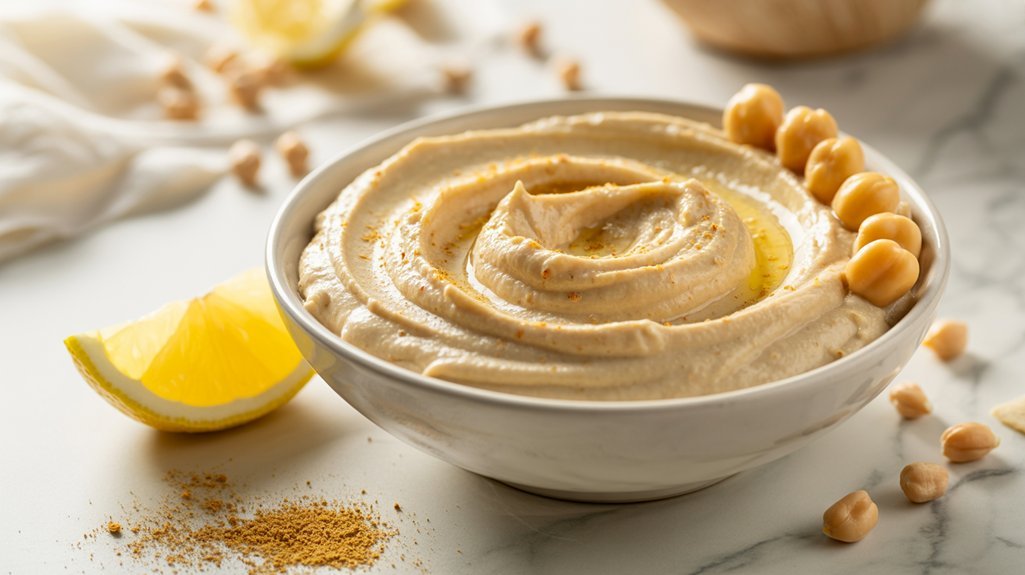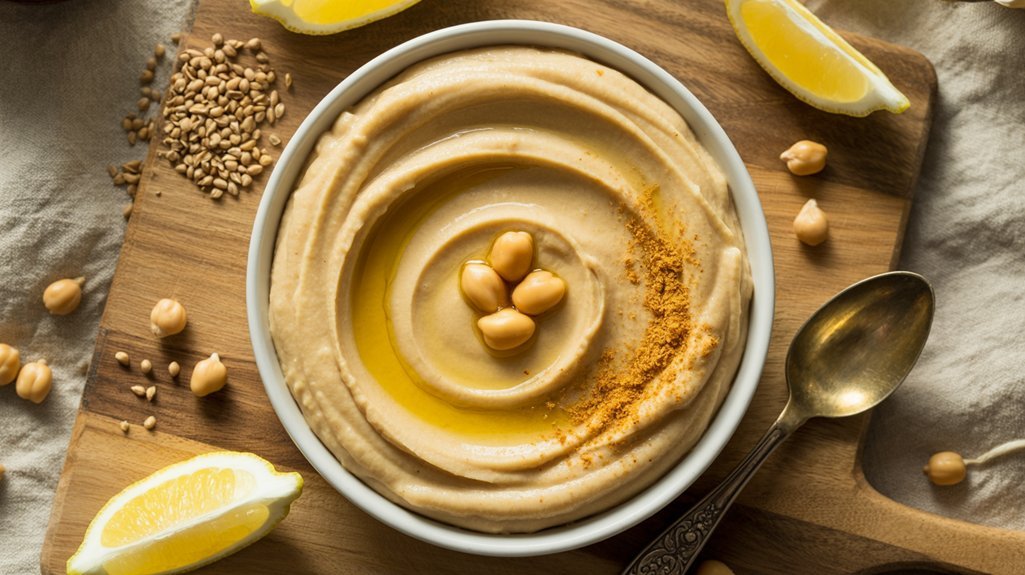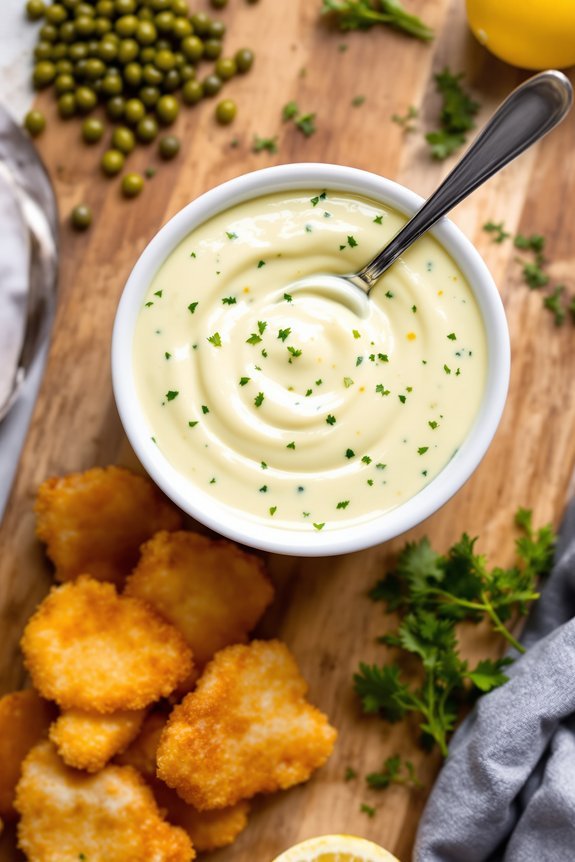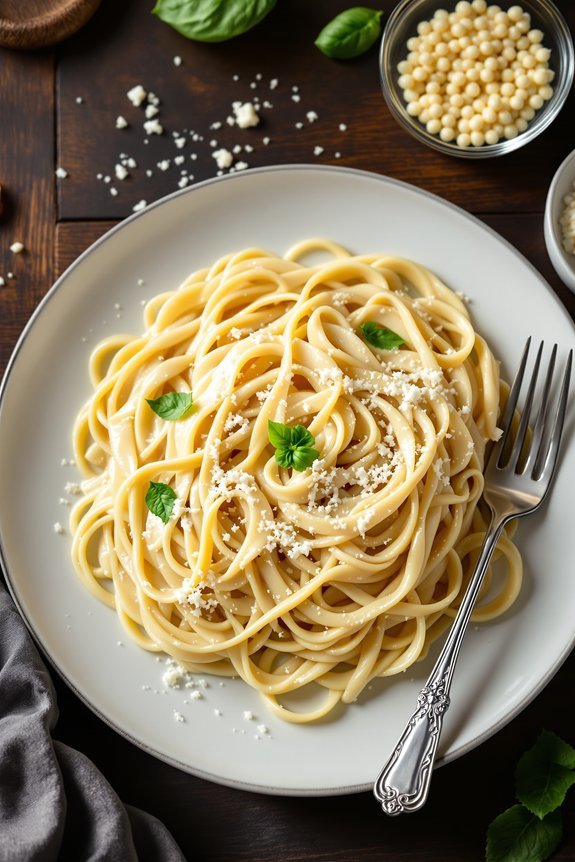I’ve spent years perfecting this hummus recipe, and I can tell you that the secret isn’t just in the ingredients—it’s in the technique. Most people struggle with grainy, thick hummus that lacks that restaurant-quality smoothness we all crave. After countless batches and failed attempts, I’ve discovered the exact method that transforms simple chickpeas into the silkiest, most luxurious hummus you’ll ever taste, and it’s surprisingly different from what you’d expect.
Why You’ll Love This Dish
While store-bought hummus fills the shelves at every grocery store, nothing compares to the rich, creamy texture and bold flavors you’ll create with this homemade version. I guarantee you’ll taste the difference immediately. The velvety texture achieves silky smoothness that’s impossible to find in commercial varieties. You’ll control every ingredient, adjusting garlic intensity and lemon brightness to your preference. This recipe’s a guaranteed crowd pleaser at parties, potlucks, or casual gatherings. Plus, making hummus from scratch costs considerably less than buying premium brands. You’ll impress guests while saving money and enjoying fresher, more vibrant Mediterranean flavors in every single bite.
Ingredients
Making exceptional homemade hummus starts with gathering the right ingredients, each playing a pivotal role in creating that perfect balance of creamy texture and bold Mediterranean flavors. This recipe uses simple, wholesome ingredients that you can easily find at any grocery store, yet when combined properly, they transform into something far superior to any store-bought version.
- 1 cup dried garbanzo beans (chickpeas)
- 3 lemons, juiced (or 90 ml white vinegar)
- 3 garlic cloves
- 1 teaspoon salt
- 3 tablespoons peanut butter
- 2 teaspoons cumin
- 1 teaspoon sugar
When selecting your ingredients, choose dried chickpeas over canned for the smoothest possible texture, as cooking them from scratch allows better control over tenderness. Fresh lemon juice provides the brightest flavor, though white vinegar works as a substitute if needed. The peanut butter replaces traditional tahini while still delivering that rich, nutty depth essential to authentic hummus. Make sure your cumin is fresh and aromatic, as this spice profoundly impacts the overall flavor profile of your finished hummus.
Directions

Begin by soaking the 1 cup of dried garbanzo beans overnight in plenty of water, allowing them to fully rehydrate and soften. This essential step guarantees even cooking and helps achieve the silky smooth texture that distinguishes exceptional homemade hummus. The next day, drain and rinse the soaked chickpeas, then place them in a large pot with fresh water covering them by about 2 inches. Bring to a boil, then reduce heat and simmer for approximately 1 hour, or until the chickpeas are completely tender and easily mashed between your fingers. The cooking time may vary depending on the age of your beans, so test for doneness regularly during the final 15 minutes.
Once the chickpeas are perfectly cooked, drain them while reserving about 1 cup of the cooking liquid, which will be essential for achieving the proper consistency. Add the cooked chickpeas to your food processor along with the juice of 3 lemons, 3 garlic cloves, 1 teaspoon salt, 3 tablespoons peanut butter, 2 teaspoons cumin, and 1 teaspoon sugar. Process the mixture thoroughly, gradually adding about 1/2 cup of the reserved cooking liquid to prevent the hummus from becoming too dry. Continue pureeing until the mixture reaches a smooth, creamy consistency, scraping down the sides of the bowl as needed to ensure even blending.
Substitutions and Variations
How can you customize this classic hummus recipe to suit your taste preferences or dietary needs? I’ll share my favorite allergen swaps and flavor pairings to transform this base recipe. Replace peanut butter with tahini for traditional taste, or try sunflower seed butter for nut allergies. Swap garbanzo beans for white beans or black beans for variety. For flavor pairings, I love adding roasted red peppers, sun-dried tomatoes, or fresh herbs like cilantro. Spice it up with harissa, chipotle peppers, or za’atar. These simple modifications create endless delicious variations while maintaining that silky texture.
Additional Things To Serve With This Dish
Discover endless pairing possibilities that transform this creamy hummus into a complete meal or appetizer spread. I love serving this with warm pita bread, fresh vegetables like carrots and cucumber, or crispy pita chips as classic pita accompaniments. For heartier options, I’ll add grilled chicken, roasted vegetables, or falafel. When it comes to beverage pairings, I recommend crisp white wines like Sauvignon Blanc, invigorating mint tea, or sparkling water with lemon. The hummus also works beautifully as a sandwich spread or pasta sauce base, making it incredibly versatile for any dining occasion.
Final Thoughts
While this homemade hummus recipe requires a bit of patience with the overnight soaking and hour-long cooking process, I can’t emphasize enough how much superior the flavor and texture are compared to store-bought versions. The cultural context of hummus runs deep throughout Middle Eastern cuisine, representing centuries of tradition and hospitality. There’s something special about preparing this dish from scratch – it transforms any gathering into an opportunity for community sharing. When you serve this silky, aromatic hummus to family and friends, you’re not just offering food; you’re creating moments that bring people together around authentic flavors.




